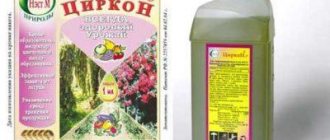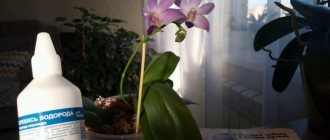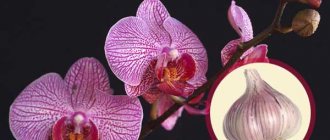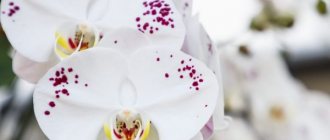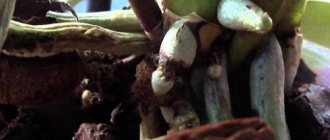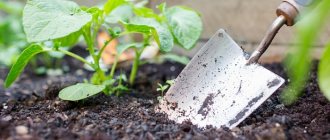To create a tropical climate for orchids at home, you will have to work hard. These exotic beauties are extremely capricious and often get sick. They don’t always like the humidity, light, or temperature in the apartment. A weakened plant is especially susceptible to fungal diseases. Their occurrence can be triggered by injury to the flower during replanting, temperature conditions, or excessive watering. The fear of losing a beautiful plant forces gardeners to look for an effective and powerful remedy for fungus. Fundazol for orchids is considered one of the most popular and universal.
How to use foundationazol correctly according to the instructions for orchids
To create a tropical climate for orchids at home, you will have to work hard. These exotic beauties are extremely capricious and often get sick. They don’t always like the humidity, light, or temperature in the apartment. A weakened plant is especially susceptible to fungal diseases. Their occurrence can be triggered by injury to the flower during replanting, temperature conditions, or excessive watering. The fear of losing a beautiful plant forces gardeners to look for an effective and powerful remedy for fungus. Fundazol for orchids is considered one of the most popular and universal.
What kind of drug is this?
Fungicides are a class of drugs designed to protect plants from fungal diseases. They can be used as preventive measures, because the fungus moves from one plant to another until it destroys all plantings. Fundazol destroys diseases from almost all parts of plants.
It has the appearance of a white powder with a specific odor. Fundazol does not evaporate and does not dissolve in water and organic matter. Active ingredient: benomyl fungicide. This component prevents fungal infections from multiplying. The fungal cells stop dividing and begin to die. In addition, the fungicide benomyl suppresses the activity of spider mites and prevents the leaf beetle from growing and becoming an adult. This is one of the few drugs that can cope with nematodes, blocking their reproduction and spread.
After the gardener treats the plants, the product penetrates through the leaves and root system. Part of the drug remains outside. When the plant is treated, carbendazim is formed, which suppresses the fungus. The infection stops spreading after using the drug.
Features of use
Benomyl spreads in plants only along the xylem in the acropetal direction, i.e. from the roots along the stem to the leaves through the vascular system that carries nutrients. Fundazol penetrates parasitic fungi primarily through their feeding appendages with suckers-haustoria. Fundazol does not spread through the phloem (the vascular system that removes plastic substances from photosynthetic organs). The integumentary tissues of plants and fungi are little permeable to benomyl. Second, benomyl is very poorly soluble in both water and most organic solvents. The “solution” of the drug is actually a suspension, a thin suspension. Further, Fundazol has little effect on fungal hyphae. And another feature essential for practice is the cumulative phytotoxicity of the drug. Up to a certain concentration, Fundazol is not phytotoxic, but its accumulation in the soil leads to plant inhibition - decreased yield, increased sensitivity to adverse conditions and diseases. Based on this, the use of Fundazol for plants is carried out taking into account the following. circumstances:
- The drug is most effective in the initial stages of the disease, when the fungal covers have not yet become stronger;
- Spraying with Fundazol is not very effective: the mushrooms will be affected only where the drug hits, and then weakly;
- The working “solution” of Fundazol greatly wears out the sprayer even with a special suspension nozzle, because the mechanical hardness of crystalline benomyl is quite high;
- If Fundazol is nevertheless used by spraying, then, contrary to the usual rules, it is better to carry it out in the morning on a sunny day (benomyl is light-resistant), when the roots and xylem are working with might and main;
- Application of Fundazol is effective by watering the soil. But at the same time, due to its high stability in the soil, the drug accumulates in it. Which, by the way, was warned about in the instructions for the first batches by the developers;
- Young shoots and, especially, peduncles from the treated plants must be removed - they will strongly draw the current through the xylem and transfer benomyl to the fruits, and almost no poison will reach harmful mushrooms;
- You also need to remove leaves that are heavily affected by the disease: the drug will not respond well to “mature” mushrooms, and again the poison will have little effect on sensitive young colonies.
Pros and cons of fungicide
Fundazol quickly penetrates the flower and affects bacterial infections. Two to three hours after application, the number of bacteria and microbes is reduced, and the spread begins to slow down. After using the product, pathogenic flora is blocked. The effect of foundationazole does not depend on the temperature during processing. The drug protects the flower equally well in heat and cold.
If more than three hours have passed after treatment, the product will not be washed off during a rainstorm. The product label indicates that the fungicide is not overly toxic. If you treat flower bulbs with foundationazole before planting, this will prevent many diseases throughout the entire growing season.
The liquid is quite flammable, so it should not be stored near open sources of fire. Foundationazol is highly flammable. The product is dangerous for aquarium fish and humans. This fungicide should not be applied to plants too often. Experienced gardeners recommend using it in the same place no more than once every three to four years.
In the United States, this fungicide is being abandoned. This drug is considered dangerous for humans and bees. The fungal infection quickly gets used to it, mutates and becomes too resistant to the effects of fungicides. At the same time, in 2014, registration of the product in our country ended, but this brand continues to be produced and used in floriculture and agriculture for treatment.
Precautions for use
When working with any toxic substance, you must be careful because it is dangerous to humans, plants and the environment. If safety measures are not followed, the orchid grows poorly, may stop blooming, and its pollen is sterilized. Chemical burns also form on the plant. To prevent this from happening, when treating orchids, you should carefully select the dosage of the drug and not use the drug too often.
When using Fundazol, the gardener must protect the skin, mucous membranes and respiratory tract from the fungicide. If the flower is processed, it should be kept at a distance from pets so that the cat or dog does not become poisoned by toxic substances.
Security measures
The stability of the drug is characterized as long-term. Therefore, after treatment, precautions are taken for at least 7-10 days (after inspection, wash hands and use protective equipment).
Hazard class – 2. This indicates an increased toxic effect on all living organisms. It is dangerous for allergy sufferers to carry out any activities with Fundazol: it causes an allergic reaction in the form of skin rashes and swelling of the mucous membranes. It has a strong effect on the reproductive system and is slightly soluble in liquid and soil. Complete disintegration occurs within six months.
It is strictly forbidden to apply the product to soil that is close to water bodies. The minimum permitted distance is 2.5 kilometers. All preparatory work takes place in the fresh air, wearing protective clothing, away from residential buildings. The product is especially dangerous when used by a woman during pregnancy.
After working with the drug you should:
- dispose of items that were used for processing;
- wash your hands under running water;
- take a shower;
- drink up to 400 ml of milk. This liquid acts as a neutralizer.
If the working solution gets on your skin or mucous membranes, go to the hospital for help. First aid is provided by washing the damaged areas in manganese or salt water. Be sure to provoke a gag reflex and take intoxication neutralizers.
Is it possible to use the pulp from the drug?
Sometimes gardeners use a remedy to treat orchids in the form of a paste. To do this, pour two teaspoons of powder into a bowl. Add a little water to the powder to mix the preparation until it becomes a homogeneous paste. The mixture should be similar in thickness to sour cream or kefir. After this, the prepared pulp is smeared on the infected areas of the flower. Additionally, gardeners treat the root system, especially if they are pruned or rotten.
This method of application has a number of opponents and defenders. Some gardeners believe that in this form the mixture is more concentrated and the orchid will recover faster. Other people familiar with the action of the drug understand that such a concentration of the substance is unsafe. In such a dosage, the gruel inhibits the growth of the plant and poisons it. It is not recommended to smear leaves, pseudobulbs and other parts of the flower with it.
This method, many gardeners believe, should be used when the roots have already been destroyed and the flower simply dies from infection. This is a measure in cases where there is nowhere to retreat and the plant will simply die without drastic action. In other cases, you should simply refrain from coating with Fundazol.
Subtleties of use
It is recommended to use the drug only for the treatment of an exotic plant, but not as a prophylaxis. The fungus quickly gets used to the active ingredient of the fungicide, so there is no need to do more than two treatments of the flower with the drug. If no effect is noticed after the first procedure, then this product is replaced with an analogue.
Processing should be carried out only in special clothing and shoes. The florist must wear a mask and gloves. The orchid is not processed in a closed room. It is best to do this outdoors. The fungicide is dissolved only in the container. No cutlery is used. After treatment, you need to wash your face thoroughly and rinse your mouth, spitting out water. One of the side effects of the wrong dosage can be growth inhibition. An orchid may simply not bloom after such treatment.
Foundationazole can be mixed when stimulating growth with insecticides and hydrogel. These agents can also be used simultaneously. The drugs can also be alternated. It is not recommended to use Fundazol with alkaline agents.
It is most convenient to work with small packages of the product so as not to calculate the dosage. It is enough for the gardener to pour half the required volume into the container. Empty the contents of the bag and add the second half of the liquid. After this, the mixture is stirred until a homogeneous solution. You can take water from the tap, but it is best to let it sit, so the powder will dissolve faster.
Some gardeners believe that the more powder they add, the better the orchids will be. This opinion is wrong. The correct concentration is important here so that the flower does not receive chemical burns. The drug is toxic. It is recommended to use the prepared solution immediately. After a few hours, the mixture simply loses its healing properties.
For which plants should the drug be used?
Fundazol can be used not only to treat orchids, but also for other plants. It is used for anthracnose, root rot, Alternaria, and powdery mildew. It is effective against mold, scab, and smut. Fundazol is used for fusarium, blackleg and other diseases.
Flowering plants, including roses, are treated with powdery mildew four times. Fruit crops can use this remedy for scab. Treatment is carried out from one to five times until the tree blooms. Gardeners recommend treating berry crops (currants, strawberries) that are affected by powdery mildew or rotting twice before flowering. For greenhouse plants, Fundazol is used as a prophylaxis even before the first symptoms of infection appear. Before planting, you can soak garlic and gladioli bulbs in an aqueous solution of the drug.
Reviews from gardeners and experts
Most flower growers and gardeners say that the drug is effective in treating many diseases. But some note its toxicity and special precautions when using it. In negative reviews, people write that the fungus quickly gets used to and adapts to this product. Experts also do not recommend using Fundazol for coniferous plants.
Experts note that gardeners often buy strong toxic drugs to treat orchids. They believe that Fundazol is a panacea for all problems and are starting to use it for prevention. This should not be done. For preventive measures, there will be safer biofungicides. If you use Fundazol too often, you can develop resistant strains of the fungus, which then cannot be cured.
Analogues of the product
There are many drugs on the modern market that can replace Fundazol. The most popular and in demand among them are:
- Vitaros is a complex seed protectant from Russian). The drug contains 2 active components - thiram and carboxin. The fungicide has a minimal level of toxicity. In terms of its characteristics, it is significantly superior to Fundazol, however, it is also more expensive (the price of a sachet containing 2 ml of the drug varies from 19 to 23 rubles).
- Topsin-M is a fungicidal agent produced by the Japanese pharmaceutical company Nippon Soda Co. The active component of the drug is methyl thiophanate. In terms of effectiveness, this product is not inferior to Fundazole, but has a longer duration of action. The cost of the fungicide is 1200−1300 rubles. for 500 g.
- Fundazim is a broad-spectrum antifungal drug used to treat vegetative plants and seeds before planting. The active component of the product is benomyl. The fungicide is produced in Ukraine, and its cost varies from 1250 to 1400 rubles. for 1 kg.
- Fitosporin is a new generation microbiological agent effective against fungi that parasitize all types of plants. The fungicide is produced in Russia. The active component of the drug is Bacillus subtilis. The product not only destroys pathogenic microflora, but also helps restore damaged parts of the plant. The phytotoxic effect of using Fitosporin does not appear even after repeated treatment of agricultural land. The cost of the drug is 25 rubles. for 10 g.
Active ingredient of the drug "Fundazol"
Under the trade name "Fundazol" a substance belonging to the chemical class of benzylamidozoles is produced. It is called benomyl and has strong fungicidal properties. It was first introduced to the agrochemical market by the notorious American corporation Du Pont back in the middle of the 20th century. Since then, controversy has not subsided around “Fundazol” and its active substance.
Benomyl is an eradicating systemic fungicide. This means that it has the following properties:
- It does not protect a healthy plant from possible infection, but kills an already developing fungus at any, even advanced, stage of the disease.
- It has the ability to spread throughout the tissues and organs of the plant and act on the fungus, regardless of its location.
Once in the plant cells, the active substance “Fundazol” undergoes a series of transformations and turns into the metabolite carbendazim. It is he who does all the main therapeutic work.
The problem with Fundazol is that microorganisms become accustomed to benomyl. This substance has been used for so long that resistant strains have emerged among pathogens that do not respond to the drug at all. Therefore, treatment with Fundazol is not always effective.
Important! On sale you can find analogues of “Fundazol” under other names – “Benorad” or “Benlat”. If the fungus does not respond to Fundazol, you should not try to treat the orchid with drugs that contain the same active ingredient.
In Russia, “Fundazol” is produced in the form of a wettable powder that forms a suspension when interacting with water. It can be found at different manufacturers of agrochemicals - Agro-Kemi, Kvadro, etc.
Foundationazole consumption rates
Dressing before planting tubers (potatoes and other vegetables) by spraying.
To prepare the solution, 10 g of foundationazole is dissolved in 0.5 liters of water - this volume is enough for 10 seed tubers. Dressing gladioli and amaryllis bulbs by immersing the bulbs for 3 hours in a solution: 10 g per 2 liters of water, garlic - in a solution for 24 hours: 10 g per 0.5 liters of water.
Instructions for using foundationazole for the treatment of powdery mildew and other diseases on indoor and garden plants: spraying during the growing season with a 0.1% working solution. 10 g of foundationazole is diluted in 10 liters of water, while 1.5 liters of solution is consumed per 10 sq.m. Spraying before flowering and after harvesting in gardening farms, or at the first signs of disease on indoor flowers.
Toxicity of foundationazole
Fundazol (benomyl) is low toxic to bees and birds. Toxic to fish. It is a highly toxic compound for humans and warm-blooded animals due to cutaneous, inhalation and oral toxicity. Prolonged contact causes dermatitis.
Security measures. When working with the drug, be sure to wear a respirator and gloves. It is advisable to dilute the working solution not in the apartment, but on the street. Avoid contact of foundationazole with eyes and skin. Eating, drinking and smoking is not permitted. After work, wash your hands and face thoroughly.
First aid for poisoning: if the drug gets on the skin, rinse with plenty of water; In case of contact with eyes, rinse thoroughly with running water; if it enters the digestive tract, drink 3-4 glasses of water, induce vomiting, take several tablets of activated charcoal, and seek immediate medical attention.
Conclusions on the feasibility of using foundationazole
When our flowers get sick, especially our favorite, rare varieties received after a long wait from other parts of our country or from abroad, we are ready to douse and spray them with anything just to save them. We don’t think much about the consequences, but in vain. It's worth weighing the pros and cons. If you are not an expectant mother, you do not have children in the house and no less valuable than plants, pets, family members with asthma or immune diseases, then you can try to save plants that are dying from an unknown disease. It is impossible to accurately determine whether a fungal or bacterial infection has affected your flowers at home. Data on foundationazole are contradictory; perhaps its effectiveness against bacteria is too negligible, and the resistance of pathogens of fungal diseases, on the contrary, is high, which means that the whole enterprise can be a lottery.
To complete the presentation, it should be noted that pesticides are divided into hazard classes not by chance; hazard class 2 of foundationazole means that it causes allergic reactions, is a probable carcinogen for humans and a strong teratogen (fetal anomalies) for animals, and has reproductive toxicity. In this case, the basesol slowly degrades in the soil; the half-life of the metabolites ranges from 3 to 6 months.
Purpose of "Fundazol" and pathogens sensitive to the drug
The spectrum of action of benomyl is quite wide, but limited. It is used to treat many plant diseases, but there are pathogens against which Fundazol is powerless:
- fusarium rot of roots and root collars;
- cercosporellosis;
- powdery mildew;
- verticillium;
- tracheomycosis.
- rust;
- Alternaria blight;
- late blight
Since Fundazol is a fungicide, it cannot be used to treat viral or bacterial lesions. Orchids suffer from bacterial infections no less often than from fungal infections, so novice orchid growers need to learn to distinguish between these types of diseases.
Release forms. Hazard Class
White or cream powder
- Can be purchased in various packages. Small packaging is convenient and practical for flower growers. 10, 20 grams per package. After all, the prepared solution should not be stored for a long time;
- Fundazol belongs to the second class of danger for mammals. This is quite a high level. Reminds me of Carbendazim and Fundazim. For birds and bees, its danger is classified as class 3-4. But its effectiveness outweighed its danger. And it was used;
- The duration of the protective effect is from 7 to 20 days;
Fundazol is a white powder that must be dissolved before use.
- What to replace : Vitaros;
- Topsin-M;
- Fitosporin;
- Fundazim;
- Derosil.
Precautions when using Fundazol for the treatment of orchids
When working with Fundazol, you must remember that any chemical is potentially dangerous for the plant itself and the environment. If the rules of use are grossly violated, symptoms of intoxication can be observed in orchids:
- growth inhibition;
- cessation of flowering;
- pollen sterilization;
- chemical burns on roots and leaves.
Based on this, treatments with Fundazol should be carried out with precautions: do not use the drug haphazardly, violating the regulations and recommended dosages.
Also, when working with Fundazol, you must follow standard personal safety measures, protecting the skin, mucous membranes and respiratory tract from contact with the powder or working fluid.
If there is a cat in the house that loves to gnaw flowers, it is better to keep the orchid treated with Fundazol away from the animal - in order to avoid poisoning.
Compatibility with other drugs, analogues
In parallel with Fundazol, growth stimulants, fungicides, pesticides, and insecticides are often used. However, mixing alkaline agents with the drug is prohibited.
To check the compatibility of plant preparations, a small amount of both preparations should be mixed in a small amount of water. If sediment forms as a result, then these products cannot be combined to treat plants.
If it is impossible to purchase Fundazol, it can be replaced with one of the following drugs: Fundazim, Fitosporin, Ferazim, Topsin-M, Derozal, Vitaros.
In addition, you can protect cultivated crops from diseases using a folk remedy such as activated carbon.
Application of "Fundazol" by spraying and watering
The official regulations for the use of Fundazol provide only two ways to use the drug - spraying on the leaves and watering. However, orchids can be processed by another method - immersion of the root system.
Before processing, a working fluid is prepared from a wettable powder:
- 1 g of the drug is measured, poured into a jar and filled with 1 liter of water at room temperature;
- the mixture is thoroughly stirred to obtain a homogeneous suspension.
The concentration of the working fluid for spraying, immersion and watering is the same. After preparation, it is used immediately:
A control test is carried out 2 weeks after the first treatment. It must be performed even if the orchid shows signs of recovery after the first procedure. There is no need to treat the plant with Fundazol more than twice.
If after the first treatment the disease continues to progress noticeably, you need to think about changing the drug.
Tip #1. Benomyl disperses through tissues from bottom to top, but not vice versa. This direction of distribution of the substance is called acropetal. This means that with “Fundazol” it is better to treat the orchid below the site of infection rather than above.
"Fundazol" is used to treat orchids only in liquid form. It is strictly not recommended to pour dry powder into the substrate.
Precautionary measures
This drug belongs to the second class of danger
For this reason, some precautions must be taken when working:
- You need to wear protective clothing, a respiratory mask and be sure to use specialized shoes and gloves.
- Eating and drinking during treatment is not recommended.
- Do not make the solution in a food container.
- After completing the work, you need to change clothes, wash your face and hands thoroughly with soap.
If the solution gets into your eyes or skin, the affected area must be thoroughly rinsed with running water for 10 minutes. If the drug gets into the stomach, it is recommended to induce vomiting and rinse.
For shoulders and birds, foundationazole is slightly toxic and does not cause a strong allergic reaction.
Fundazol should be stored in a place isolated from animals and children. It should be both dry and cool.
With proper treatment, the disease goes away quickly enough, getting rid of fungi and infections that milder drugs cannot cope with.
The use of "Fundazol" in the form of a slurry: pros and cons
In practice, orchid lovers very often use Fundazol in a way not provided for by the regulations - in the form of a paste. This paste is prepared as follows:
- take a tablespoon of powder;
- add water little by little, stirring with a wooden skewer;
- achieve a creamy or kefir-like consistency.
The product prepared in this way is taken with a brush and smeared onto the infection-damaged areas of the orchid. This technique is especially often used to treat rotten and cut roots.
This method has many supporters who believe that the pulp from Fundazol is a wonderful remedy against the spread of infection. However, this method of use raises doubts not in terms of effectiveness, but in terms of safety.
Elevated concentrations of benomyl have a depressing effect on plants. In no case should you smear the green organs of orchids with the paste - leaves, pseudobulbs, peduncles. The “coating” method can be justified only in one case – when the plant has completely lost its roots and dies from infection.
Advantages and disadvantages. Differences from other drugs
For a long time, flower growers have been choosing it because of its advantages and benefits :
- Versatility and wide range of applications;
- Penetrates the plant quickly and immediately acts on diseases or pests. Within 2-3 hours after treatment, the spread of the disease is inhibited. Pathogenic microflora is completely blocked within 24 hours;
- Does not depend on temperature . Protective properties are maintained at high and low temperatures;
- After a short time (about 3 hours), rains are not dangerous for him;
- The toxicity level is not high;
- Bulbs treated before planting provide plant protection throughout the growing season.
Fundazol has both its advantages and disadvantages.
Consider the disadvantages of this fungicide:
- Do not store or use near open fire. The composition is highly flammable;
- Quite dangerous for humans. And pet fish;
- It cannot be used often. Experts advise using it on one area only after 3-4 years.
Reviews from flower growers about the use of "Fundazol" for the treatment of orchids
“Fundazol” is indeed on the list of the most popular fungicides among orchid lovers. This even led to the emergence of a slang verb - “foundation”. For the most part, the use of this drug for treatment is effective, although there are opposing opinions:
“I recently noticed some nasty mold on the roots of my phalaenopsis. I watered it with Fitosporin, but after a month not only the roots in the pots began to mold, but even the aerial ones. Out of fear, I took “Fundazol” and foundationalized my entire orchids - and watered and sprayed them. All the flowers immediately fell off, but the mold disappeared and has not yet returned” (Evgeniya, St. Petersburg).
“I threw this drug out of my “flower medicine cabinet” a long time ago and forever. Three years ago I got a new Vanda, which was brought to me from Thailand as a gift. Together with Vanda, a particularly malicious spot came into the house, which manifested itself after quarantine and infected almost all the orchids. Out of habit, I tried to treat with Fundazol - zero reaction. As a result, I lost time and 3 excellent copies. The rest were saved by the usual ambulance. I think Asians abuse benomyl on their farms, that’s why this happened” (Oksana, Yekaterinburg).
Expert opinion on the preventive use of Fundazol
There is another subtle point regarding the use of Fundazol, which some experts mention:
“In my practice, I have come across the fact that flower growers use very strong chemicals to prevent infections. For some reason, “Fundazol” is especially popular, which is considered almost a panacea for all orchid ills. This is a serious mistake. For preventive purposes, you need to use simple and harmless biofungicides or, in extreme cases, non-systemic drugs. And “Fundazol” is an eradicating agent. If you just pour it on your orchids, in the future you can breed resistant strains of fungi in your flower garden, which will be very difficult to get rid of.”
A. Davydovskaya, owner of the greenhouse
Current questions about the drug "Fundazol"
Question No. 1. Is it possible to combine Fundazol with Fitosporin?
Can. “Fundazol” is an antifungal agent, and “Fitosporin” contains bacteria. Benomyl has no effect on them, like all other bacteria. Therefore, treatments with “Fundazol” and “Fitosporin” can be carried out simultaneously. Another tactic is also possible: do the first treatment with “Fundazol”, and the second, after 2 weeks, with “Fitosporin”. This will help reduce the pesticide pressure on orchids.
Question No. 2. Is it true that pregnant women cannot work with Fundazol?
Rumors about the teratogenic effect of benomyl have been circulating for a long time - both in the Western press and in Russia. No one has yet been able to prove this. Officially in Russia, benomyl preparations are classified as low-hazard to humans. But if there are any fears and doubts, it is better to put “Fundazol” away during pregnancy and treat orchids with biofungicides.
How to use the drug?
Two milliliters of concentrated emulsion are diluted in one liter of water (for private households this is the standard dilution of the drug). The resulting fraction is used immediately. All manipulations with the drug are carried out using glasses, a cotton-gauze bandage and gloves, since the product belongs to the third class of danger.
Options for using the working solution:
- the seeds are soaked in Vitaros solution for 2 hours and then transplanted into the ground;
- spraying (uniformly) of planting material with its further sowing;
- treatment of seeds to be stored (soak for 2 hours, let dry);
- the drug is used to prevent infectious and fungal infections of plots.
Judging by the reviews, “Vitaros” is an effective remedy that protects tubers and flower bulbs (during storage) from all kinds of rot. Many gardeners use the drug to treat the rhizomes of balcony and indoor plants during transplantation and handling.
How to use Fundazol for orchids: subtleties of fungicide treatment
Gorgeous orchids are the pride of flower growers, and it’s especially disappointing when they start to get sick. Today we will talk about all the subtleties of how to use Fundazol for orchids. This is a very effective drug, but at the same time quite strong. If you get carried away with a fungicide, you may not only not help the plant, but even completely destroy it. In addition, its use is not always effective, because the product has its own specification.
Treatment for fungal diseases and rot
Many diseases can be treated with this drug. It is better to use it in individual areas of infection. In apartments you should not spray plants with it. Or combine it with foliar feeding . List of diseases against which the drug is effective:
- Anthracnose;
- Gray rot;
- Fusarium;
- Late blight;
- Fomoz;
- Septoria;
- Powdery mildew.
When is the use of the drug justified?
The active ingredient of Fundazol is benomyl. It quickly enters the plant itself and spreads through the leaves. The drug copes well with fungal diseases, but is powerless against viral and bacterial infections.
A systemic fungicide will help cure orchids from the following diseases:
- fusarium rot;
- powdery mildew;
- tracheomycosis;
- verticillium;
- cercosporellosis.
The drug is powerless against downy mildew, late blight and alternaria.
Fundazol should only be used to treat orchids. It is not used as a prophylactic agent. Moreover, the fungus quickly gets used to benomyl, so the maximum number of treatments is no more than two. If there is no effect after the first procedure, then you should change the drug to one that contains a different active ingredient.
Reviews
Elena P. “I haven’t used this drug for a long time. After I learned in detail about its properties. For orchids, it is suitable only in case of severe root disease. When they are very rotten. A paste of powder is prepared. All damaged and dried roots are cut off.
The remaining roots are lubricated. The use of foundation is one-time only. After all, it slows down growth. Plants develop slowly after its use. They may not bloom.”
Anastasia L. “I always have foundation in stock. Not so often, but you have to deal with driven roots. Especially after buying brand new orchids. I give them all the opportunity to adapt themselves for 2-3 weeks.
Fundazol is very popular among buyers.
And more often you have to replant. I take a good look at them. I remove all damaged and diseased ones. I will treat the cuts with activated carbon. I prepare porridge from foundationazole powder. I coat all the roots with a brush. I let it dry for a couple of hours. I coat it again. Only then do I plant it in my container.”
Sergei Mironov. “An old and proven remedy against many diseases. Even many representatives of the microflora have developed a protective reaction. Gardeners continue to use it out of habit. I wouldn’t recommend it for orchids either.
Only in situations where there are problems with the roots. It is not suitable against downy mildew and rust. More effective drugs are quite enough now. Especially for owners of a small number of orchids in the apartment. The same Topsin-M. And another piece of advice. Don't let your orchids get into this state. To use foundationazole."
Nikolay Samarin. “I’ll tell you something about Fundazole. They talk about its acaricidal (against ticks) and nematicidal (against small worms) effects. So here it is. This has not been confirmed by any studies. Some people succeeded. According to their stories. Or self-deception. Or a good coincidence.”
How to use Fundazol for orchids: methods of treating plants
The fungicide is available in the form of a soluble powder. Based on it, a working solution is prepared (1 g of the drug per 1 liter of water) and orchids are treated with it in one of the following ways:
- Spray leaves, stems, bulbs.
- Spill the bush after placing it in a bowl. In this case, the substrate must be moist, and no more than 1 tbsp is “wasted” on one orchid. solution.
- Immerse the roots and leave for a quarter of an hour.
If the disease is advanced and the orchid’s roots have already rotted, an emergency method can be used. Make a paste from the powder by adding a little water. Apply this mixture to the remaining rosette or remaining roots, cleared of rot. It is strictly forbidden to treat healthy leaves, bulbs and peduncles.
Do not exceed the recommended dosage and frequency of flower treatments. The fungicide, although good, is very strong. It will kill the fungus, but the orchid itself may stop growing and blooming. Repeated treatment is carried out no earlier than after 2 weeks. If necessary, Fundazol can be combined with Fitosporin.
Recommendations for use
"Fundazol" is a very effective drug, but high efficiency can only be achieved with proper use.
Consumption rates and number of procedures
The dosage of the drug depends on the object of treatment:
- affected plants – 10 g per 10 liters of water;
- seed – 10 g/l;
- land for planting - rationing is similar to infected crops.
To disinfect the rhizome, gardeners recommend preparing an ointment by diluting a little dry chemical with water. Author's advice
The number of treatments directly depends on the disease:
- seed mold – one-time use;
- bulb rot - twice;
- withering - similar;
- ashtray - at least three times;
- spotting - four times.
Table: Drug consumption rates
Seed dressing
Seed material can be processed at any time: before or before sowing. To achieve the greatest effect, gardeners advise adhering to some rules:
- The seeds need to be filled with fungicide and left for a quarter of an hour. Then place them on a paper towel and let them dry.
- If it is necessary to pickle the bulbs, they should be sprayed with a solution of Fundazol at the rate of 10 g per two liters of water.
- Before planting, tubers are usually soaked for 15-20 minutes using a diluted preparation.
Processing of vegetable and horticultural crops
As already noted, the number of procedures and normalization depends on the type of crop being processed. Let's take a closer look at this point:
- Ornamental plants are sprayed 4 times.
- For fruit trees, 5 treatments are recommended before flowering.
- Berry crops will be saved by 2 procedures carried out before the buds open.
- Tomatoes and cucumbers are sprayed at the first signs of disease.
- To prevent cabbage from clubroot, it is enough to treat the soil for planting once.
- To avoid potato contamination, it is recommended to soak the tubers in a fungicide before planting.
- Bulb crops are processed in a similar way.
Orchid processing
Very delicate orchids react sensitively to potent drugs. However, they can also be treated with Fundazol:
- Cut off the top of a plastic bottle to make a kind of pot.
- Pour dry soil after mixing it with polystyrene foam.
- Moisten the resulting substrate with a chemical diluted with water.
- Replant the flower.
Protection of flowering ornamental plants Treatment of garden crops Protection of grapes Spraying of garden crops

